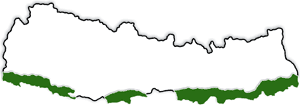 The Nepal tarai as an area of study is still a virgin territory. Even though it is home to over half of all Nepalis the region is little studied and even less understood.
The Nepal tarai as an area of study is still a virgin territory. Even though it is home to over half of all Nepalis the region is little studied and even less understood.
The tarai and madhes are mistakenly used synonymously. Actually the tarai is a geographical area with different communities as its residents, while madhesh is a cultural space with madhesis as its inhabitants. Ignorance alone, however, doesn't fully explain the apathy towards the tarai in general and madhes in particular. Partly, it is because of the way the Nepali identity has evolved over the centuries.
King Prithbi Narayan Shah built modern Nepal upon the strength of his determination and that of his Gorkhali army. He later imagined his kingdom as a garden of 'four castes and 36 races' that populated the hills and valleys of Mahabharat range. Readings of his Dibya Upadesh reveal that madhesis figured in his formulation primarily as the 'other', the group to be feared.
After the transformation of Kunwars into Ranas, Nepal's hereditary premiers ran the country as a family fiefdom. They needed madhesis to exploit the forest and agricultural resources of the tarai. Hence, some madhesis found a place at their feet. But even they remained less than subjects, with almost no contact with their rulers in distant Kathmandu Valley. Madhesis needed visas to travel to their own capital.
The imagination of Nepal as a nation is a relatively new phenomenon. It began as an offshoot of the Indian independence struggle when some articulate Gorkhalis in Darjeeling and Kasi came up with the notion of Nepal as the fatherland of Nepalis everywhere. Markers of this de-territorialised Nepali identity were based on the monoculture concept of one language, one religion and one people. The Nepali language, Hinduism, a martial tradition, an anti-Indian self-description, and kingship are five symbols of this new Nepalipan. When the Shah Restoration accepted this formulation, even madhesis who were beneficiaries of the feudal state were pushed away.
After 1960, the promotion of a unified mainstream culture became the kingpin of Panchayat nationalism. Patriotism during the first decade of the Panchayat regime consisted of unconditional loyalty to 'one language, one dress, one religion, and one people under the all-powerful monarchy'. But even when politics became a little more open after the 1980 referendum, there was no let-up in the attempts of 'Nepalising' madhesis. Those who couldn't or refused to be assimilated in the mainstream were vilified as anti-national or worse. Right up to the 1990s madhesi remained a derogatory term in elite circles.
The 1990 People's Movement raised hopes of an inclusive identity, but couldn't fulfil the aspirations of the main externalised population group of Nepal. The new constitution cites the upliftment of the marginalised through legal guarantees and remedies, but it refuses to even recognise that madhesis have been systematically excluded for centuries and gives continuity to the assimilation model of constructing a homogeneous Nepali identity based around the five symbols of Nepalipan.
Even today, while women, dalit, the poor, gays, janjatis, and even foreigners married to Nepalis seek due recognition, tarai-basis are still left out. The dominant Nepalipan model still prevails over the concept of an egalitarian 'Nepaliyata'.
The Maoists for their part are obsessed with the notion of class and are inherently incapable of producing a blueprint of an inclusive and democratic Nepali identity. Their creation of regional autonomous regions is a PR exercise since totalitarianism is antithetical to the aspirations of the left out.
There can be no harmony without the acceptance of multiple identities. Pluralism is a prerequisite to peace and justice. The two-day international conference on 'Nepal Tarai: Context and Possibilities' that began Thursday is a pioneering effort to clear conceptual confusions and lay the groundwork for more substantive tarai studies in future. It is a time to end persistent externalisation of nearly half of the country's population.



